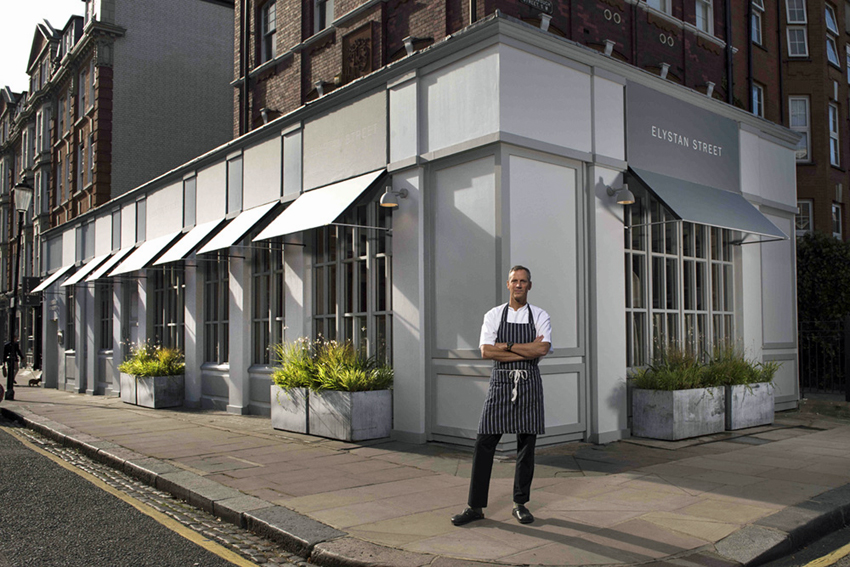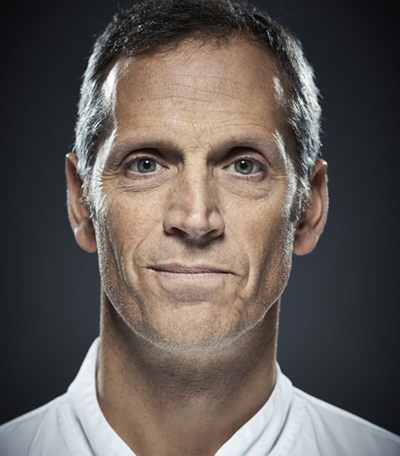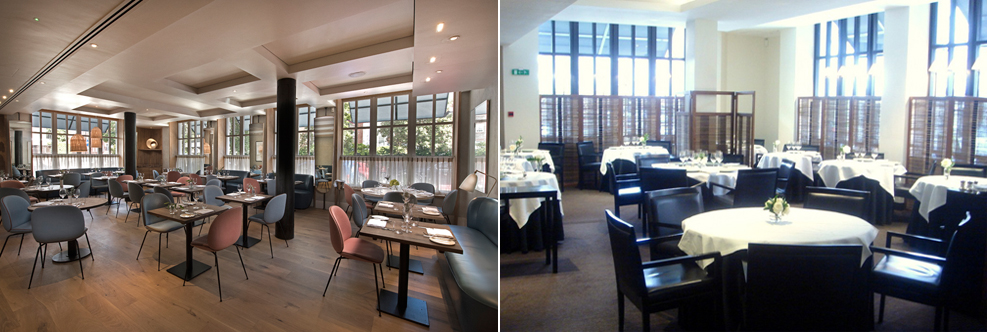After a tremendously successful 25 years at The Square, iconic ‘chef’s chef ‘ Phil Howard and business partner Nigel Platts-Martin sold the Michelin two starred Bruton Street restaurant to Marlon Abela Restaurant Corporation (MARC).
Phil Howard has relatively quickly returned to the kitchen at the old Tom Aikens’ restaurant site on Elystan Street in Chelsea. The new venture, which is named after the street it occupies, promises to deliver a combination of neighbourhood and destination restaurant to its local and traveling clientele.

The restaurant extends Phil’s successful business partnership with Rebecca Mascarenhas, forming a restaurateur/chef team that includes the sites Kitchen W8 in Kensington and Sonny’s Kitchen in Barnes. As a strong team that understands both the food and business needs of particular markets they can rightly expect to make a success of this new venture Elystan Street.
Upon entering, the transformation of the space from it’s former guise was a clear contrast: The interior design of the 64-seat dining room featured chairs in two shades (air force blue and soft salmon), and sofa banquettes in teal leather. Tables were a mix of oak and concrete tops, and the lighting included numerous resin spun pendants. Two walls featured almost floor-to-ceiling windows with café-style curtains providing low-level privacy.
I am shown too, into the makings of the 14-seat private dining room, which featured a clever adaptable table and stools, that could be raised or lowered to suit either a dining function or for more informal canapé and drinks. The table’s steel base was topped by white Corian, and there were long tubular lights made in marble.
Two weeks prior to official opening, Phil and Rebecca found time to sit in the new dining room at Elystan Street and discuss their restaurant with Simon Carter of fine-dining-guide.
Tell us about your new project at Elystan Street?
Phil: Elstyan Street offers us very exciting and vibrant new space for a restaurant venture. The idea is to set up a restaurant which is absolutely aimed at what Rebecca Mascarenhas and I perceive the market to be in this part of London.
This is an important point because gone are the days when a restaurant, whatever its purported ‘identity’ can come into an area of London and dictate what will sustain a full restaurant of customers, at a lunch and dinner service, without due deference to the tastes of the neighbourhood.
 So we have to look, listen, reflect and create menus with elements that are lighter, cleaner, perhaps more vegetarian influenced. You might find demand for less dairy or gluten but when looking at the menu you perhaps wouldn’t notice these attributes, however some subtlety of thought has gone into that, particularly at lunch time. So to feature salads, Carpaccios, certain raw foods and so on will be items taken on board as a conscious decision, however there will also be provision along side these dishes for tastes that are looking for more ‘destination’ style food.
So we have to look, listen, reflect and create menus with elements that are lighter, cleaner, perhaps more vegetarian influenced. You might find demand for less dairy or gluten but when looking at the menu you perhaps wouldn’t notice these attributes, however some subtlety of thought has gone into that, particularly at lunch time. So to feature salads, Carpaccios, certain raw foods and so on will be items taken on board as a conscious decision, however there will also be provision along side these dishes for tastes that are looking for more ‘destination’ style food.
How does this opening compare to your days at The Square?
Looking back, an over-riding feature of top end dining in London was the significant market change over the life of The Square; tastes and offerings became more diverse as the choices customers faced became more numerous.
While at one time, The Square may have been on a top end restaurant diner’s list of five ‘proper food’ destination restaurants to visit in London, nowadays people (pleasantly) find an extraordinary mix of food types and styles to consider. It is no longer a sustainable business model to just serve a great plate food in a relaxed formal environment and hope or expect to regularly fill the restaurant. Much more thought is required on what type of identity of restaurant you are reflecting back to a given market space in your part of town.
So the market at Elystan Street is completely different, hence a different offering?
I might suggest that at lunch time in Elystan Street there are almost three distinct lunch time food requirement markets solely based on day of the week, the way people think about their food needs might vary between weekdays versus a Saturday versus a Sunday.
So Rebecca and I have thought carefully about a flexible, adaptable and accessible restaurant vision in the modern world. In this context it is also about personal job satisfaction – getting it right – delivering a quality product and making the restaurant successful at this venue. I am excited, ambitious and happy to deliver a restaurant, which is very new, which applies the disciplines of delivering consistent quality that people know me for from The Square and applying that to a modern 2016 dining concept at Elystan Street.
So these are different career goals from The Square: Still cooking! No stepping back?
The Square ticked all the career aspiration and cooking boxes for me and was a great success for a long time. Ultimately I look back on that journey with a great deal of pride and satisfaction. Achieving two Michelin stars, gaining a solid chef reputation at the top end of the industry, while cooking some serious food.
Make no mistake I am not ‘stepping back’ nor drifting off into semi-retirement, quite the opposite! I retain the desire to put on my chef’s whites but at the same time to put my ego to one side; to adapt my skills to gain complete satisfaction from the mission to prepare and deliver consistent, quality food that will fill a modern restaurant in this part of town – lunch and dinner! This is the new challenge, certainly no stepping back, but fully focused and forward looking about what I wish to achieve in the business.
Rebecca Mascarenhas: Dining out has perhaps become less about special occasion dining and about more regularly visiting restaurants that have a slightly different product offering – a relaxed warmth of welcome, in a light and airy space, while providing food that matches their high level of intelligence about what they are eating in a social meeting place – which while being a ‘grown up’ restaurant – it is not a restaurant for a restaurant’s sake.
Editor’s Comments: The theme is that a restaurant today is a home for a set of needs of target customers compared to a vent for what a high-end chef chooses to create (without regard for the market space). The latter once had a natural and strong independent restaurant market but today, people’s needs in different parts of town require more thought put into the offering to get it right.
Two fundamental facets of the great restaurants, the temples of gastronomy, was the personality of the house developed in tandem between the chef and the key personnel out front and from a food perspective the signature dishes.
What Phil Howard achieved at The Square was about more than exceptional and consistent food but the consummate front of house professionals such as John Davey, David O’Connor and Cesar Lopes who developed their own ‘club’ of returning guests; like coming home to family for a hospitable chat and a warmth of welcome combined with first rate execution of the science of service. The art of making someone feel good was a feature of The Square that became associated with the chef, too!
Perhaps the modern vision of this scenario is the guests will treat a restaurant aimed at this space as a social meeting place where the venue automatically turns into a returning guest club because the feel good factor is generated by the package of the venue itself: The right type of meeting place where they happen to eat and drink?

Phil Howard Elystan Street 2016 (left), Tom Aikens’ Restaurant 2009 (right). Same space: The shifting needs of a venue in modern top end dining!
This assertion goes too far, venue presentation is one thing, food presentation another and so this significantly understates the value and importance of Phil Howard as the chef at the venue! To establish this only takes a matter of reviewing the dinner menu. While certain food content dinner presentations are less relevant, for example tasting menus, which are not currently offered at Phil Howard’s Elystan Street, signature dishes, which naturally take time to develop, will remain likely to be relevant and further important for business. At The Square the Michelin two star signature dishes (being those listed in the Michelin Red Guide each year) were a symbol of the cooking that gently defined the chef’s work – Langoustines, Crab or Brillat-Savarin Cheescake – which as Phil Howard says “could alone take care of business during a dinner service.”
The first impression of the dinner menu at Elystan Street is that it is born of The Square – essentially with a cleaner, lighter touch and a modern twist, but still with a Phil Howard identity. Clearly evident at dinner is an evolutionary rather than revolutionary tone for Phil at this stage of the restaurant. From these early menus signature dishes can most certainly develop and should these retain the impact that similar dishes held at The Square then this bodes well for business. This is further enhanced by the fact that even though the market is now more firmly with the social and dining requirements of the local customer there will remain a strong flow of clients traveling to Elystan Street, to once again enjoy a memory of the food they’ve always loved at The Square. So once again, a well thought out, winning recipe for the new restaurant!
Phil Howard is a truly iconic chef, and with the partnership of Rebecca Mascarenhas (and formerly Nigel Platts-Martin) builds formidable businesses. Fine dining guide will continue to follow his great career with full admiration and best of wishes for the future.



